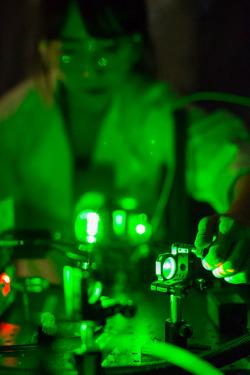Today’s smart phones, laptops and computers rely on electronic chips and transistors that operate based on current flow. Since the invention of integrated circuits, and in order to achieve higher and better performance, the density of transistors has been increasing.

Nanoscale building blocks in 2D-material, photonic crystal cavity with single photon emitters. Photo credit by Dr. Toan Trong Tran.
However there are fundamental limits to how small these circuits can be made. Using photonics is one possible solution but nanoscale building blocks, called photonic crystals, need to be engineered in order to confine and manipulate light at the nanoscale.
Now UTS led research has demonstrated an integrated photonic device made entirely of atomically thin materials that can confine light into sub-micrometre scale spaces. This study brings 2D materials one step closer to applications in integrated quantum photonics.
These nanoscale building blocks are periodic structures of tiny mirrors arranged in a special fashion that can manipulate and confine light. This new study shows for the first time that an atomically thin material, hexagonal boron nitride (hBN) can be used as a platform to build an integrated photonic device. The research is published in Nature Communications.
Joint first author Dr Sejeong Kim, a physicist from the UTS Institute of Biomedical Materials and Devices (IBMD) says that the team was able to "exploit the layered nature of this unique material, hBN, to fabricate photonic devices, with a thickness a thousand times smaller than a grain of sand."

IBMD researcher Dr Sejeong Kim and colleagues are fabricating photonic devices, with a thickness a thousand times smaller than a grain of sand. Credit: Anna Zhu.
"Our research is a first step towards using photonics, light, instead of electrons and solving the bottle neck of modern electronics," she says.
The unique advantage of hBN is the ability to host quantum light sources – atomic impurities that emit only one photon at a time. These sources are a fundamental building block for quantum computers and quantum communications. Yet to find truly practical applications such emitters have to be integrated into photonic devices to perform logic operations - until now this has not been demonstrated before with atomic materials.
Co-first author, and IBMD PhD candidate, Johannes Fröch says that “fabricating such high quality devices was really challenging for our nanofabrication."
“We had to invent a lot of the processing steps, since no other group has shown these devices from hBN before.”
The research team includes industry partner Thermo Fisher Scientific, who are interested in developing novel nanofabrication approaches, and the National Institute for Materials Science, Japan.
Lead researcher, and co-author, IBMD Professor Igor Aharonovich says that the research outcomes are highly significant because the team was the first to demonstrate “practical, scalable devices from atomically thin materials for integrated circuits.”

